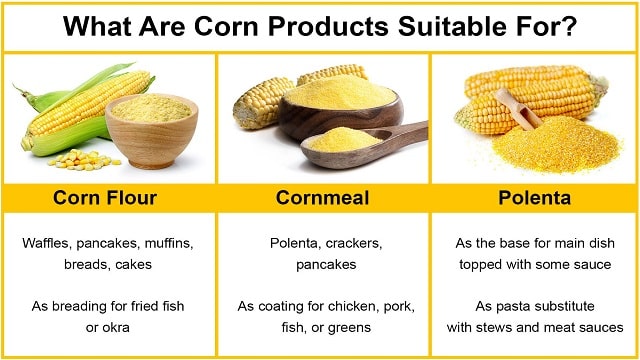Polenta, cornstarch, and corn flour come from the same grain, but they are not the same. We tell you the differences between them so that you know how they are used in the kitchen.
Corn and its byproducts came to us through Native American cultures that treasured it as one of the most valuable ingredients in their gastronomic culture. There is no doubt that following its introduction to our continent, both corn and its derivatives have become an indispensable element in our culinary repertoire.
So much so that it would be difficult to imagine recipes without using three of the most common corn derivatives in gastronomy: polenta, cornstarch, and corn flour. We want to know a little more about the three products and above all the differences between them to avoid confusing them.
What is polenta
Polenta is a dish originally from Italy that served as the basis of the peasants’ diet thanks to its versatility, its nutritional value, and its low cost. It is a simple dish obtained after cooking raw and ground corn kernels in water.
What is cornstarch
Cornstarch is known in Spain as corn flour and acquires the commercial name of one of the best-known commercial brands, maizena. Actually, cornstarch is just raw, cooked, and dried cornstarch. The result is a very fine powder that can be used as a thickening agent in many recipes, in addition to serving as a base for making dough.
What is corn flour
For its part, corn flour is nothing more than the result obtained after grinding the whole, raw corn grain. This process produces a fine flour that can be used as the main ingredient in numerous culinary recipes.
Differences between polenta, cornstarch, and corn flour
Although these three terms have one point in common, which is that they are obtained from the same ingredient, corn, the main differences between polenta, cornstarch, and corn flour are: their classification, their composition, and processing, their flavor and texture. , and its different culinary uses.
Polenta is a dish
The first difference that we must highlight between polenta, cornstarch, and corn flour is that not all of them are ingredients. While cornstarch and corn flour are ingredients that can be used to prepare various recipes, polenta is considered a dish made from cooking ground corn and is not classified as an ingredient in itself.
Cornstarch only contains cornstarch
Another key difference between cornstarch, polenta, and flour is that only cornstarch is used to make cornstarch, which is ground so that the result obtained is a very fine powder (even finer than corn flour). corn). On the contrary, to make polenta and corn flour, the entire corn kernel is used, which after several grindings is crushed until granules of different sizes are obtained.
Flour and polenta taste more like corn
Another notable difference between the different terms is the texture; While polenta is a very fine grain, which after cooking with water acquires a creamy texture, cornstarch is a very fine powder that, when mixed cold with a liquid solution, will thicken in just a few minutes of cooking. For its part, corn flour has a slightly coarser texture than cornstarch, but finer than polenta.
For its part, cornstarch has a more neutral flavor, making it ideal to use as a thickener in various recipes. Polenta, on the other hand, has a marked corn flavor, which, however, absorbs the flavor of the liquid with which it is to be prepared quite well. In the same way, corn flour is characterized by that sweet flavor typical of corn grain but a little softer.
Culinary uses: from the masses to the table
Starting from the basis that corn flour and cornstarch are ingredients to make different recipes or complement them, and polenta itself is consumed as a food, let’s see what their different culinary uses are.
To prepare polenta in the most classic way, it would be enough to cook it for 40 minutes in a good amount of water with a pinch of salt. From that base, you can replace the water with any poultry, meat or vegetable broth to enrich its flavor.
Unlike polenta, which as we see is a recipe in itself, both corn flour and cornstarch are classified as ingredients that are not consumed by themselves, but are used to prepare all types of preparations such as doughs, and breads. , biscuits, batters, and even as a sauce thickener in the case of cornstarch thanks to its powdery texture.
A host of gluten-free recipes can be prepared with corn flour, such as fried foods, batters, empanadas, arepas, breads, and pizza doughs. In the same way, sweet recipes based on corn flour can be cooked, such as corn cakes, cakes, tarts, cookies, pancakes, sponge cakes, alfajores.
As for cornstarch, beyond using it as a thickener for sauces and basic preparations such as roux, it can be used in recipes such as savory chicken or vegetable cakes, croquettes, thin batters… And if we are looking for a result with a softer texture in our sweet preparations, gluten-free sponge cakes prepared with cornstarch are very spongy and soft.
